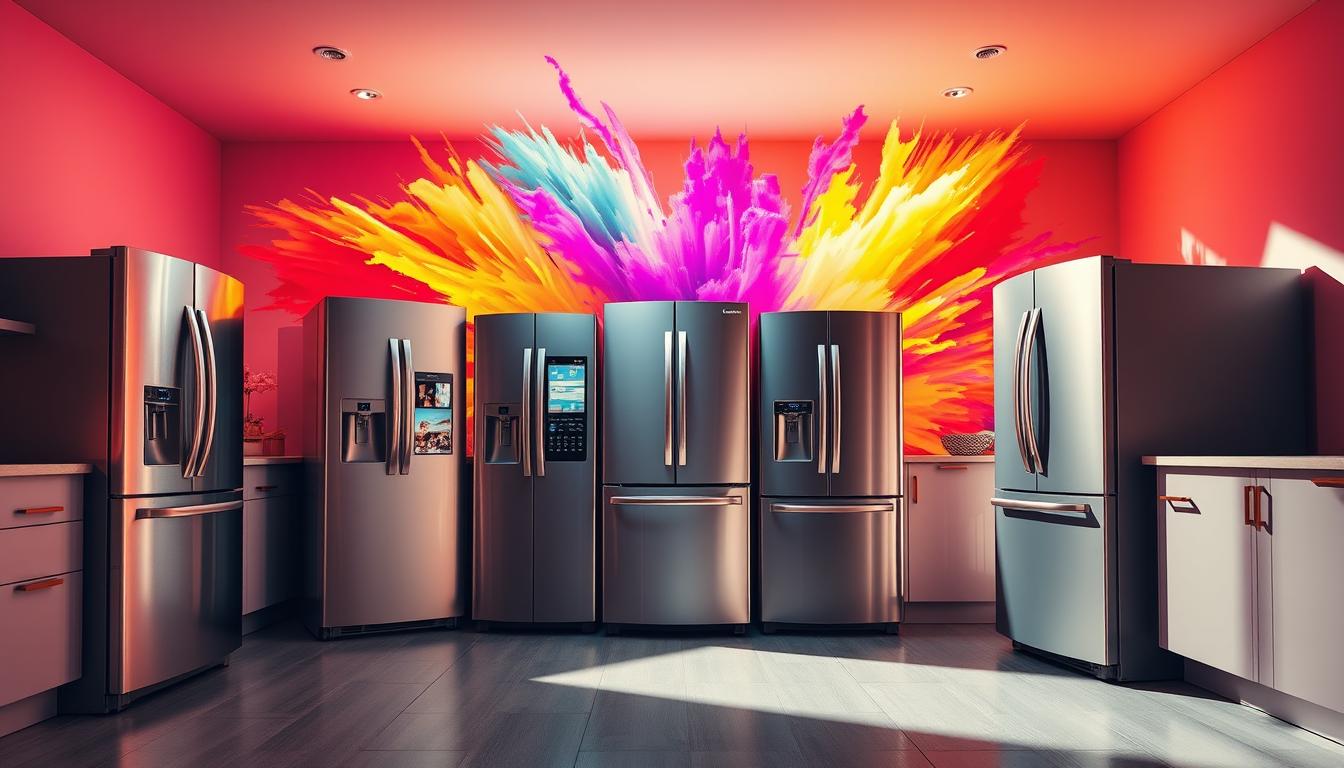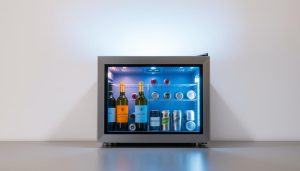Did you know your fridge could cost you over $150 more in annual energy bills than a modern alternative? Consumer Reports found that old fridges waste money, while new ones save up to 40% on energy. With electricity prices going up, picking the right fridge is a smart financial move.
Today’s top fridges use cool tech and smart features that learn your habits. Brands like LG and Samsung have fridges that adjust temperature based on how you use them. Whirlpool and GE focus on lasting quality, with compressors that last over 15 years. Even Frigidaire’s budget options beat old fridges in energy tests.
Energy Star ratings are key in 2024. The best fridges use 15% less energy than the law requires. Over ten years, this could save you enough for a weekend getaway or a new fridge. But not all Energy Star fridges are the same. We’ve looked at costs, repair rates, and real-world use to find the best.
Key Takeaways
- Annual energy costs vary by $150+ between old and new refrigerators
- LG and Samsung lead in smart cooling automation
- Energy Star ratings now exceed government baselines by 15%
- Whirlpool’s dual-evaporator systems prevent flavor transfer
- 10-year ownership costs include repairs and efficiency drops
Why Energy Efficiency Matters for Modern Kitchens
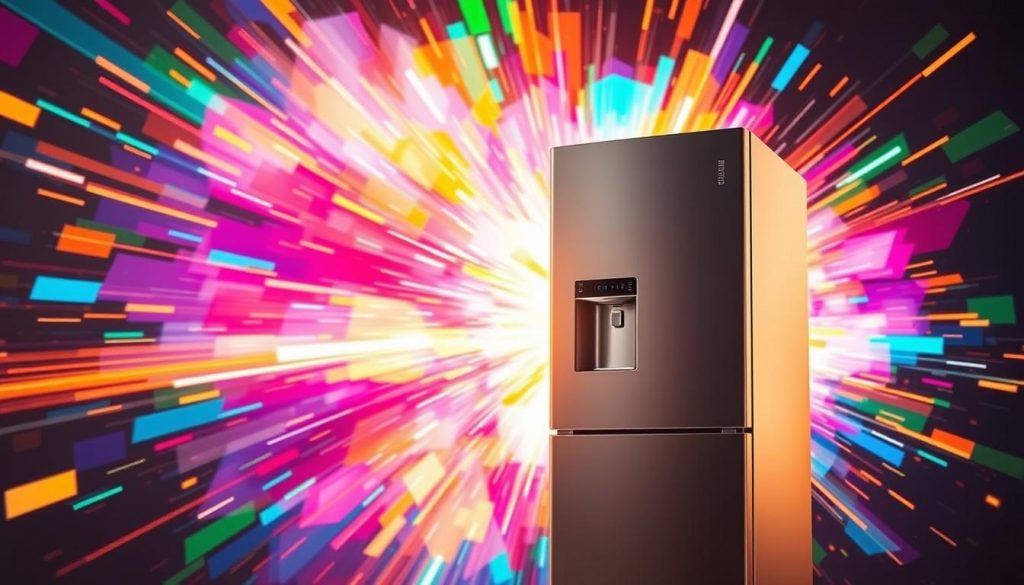
Your refrigerator works all day, every day. Its energy use is key to cutting down on emissions and saving money on bills. Standard models use 40-100 kWh each month. That’s enough power to run a LED TV for 300-750 hours.
ENERGY STAR-certified refrigerators use 10% less energy. This can save you $50-$100 a year, depending on your electricity rates.
Modern eco-friendly refrigerators save energy in several ways:
- Inverter compressors adjust cooling as needed
- Triple-pane glass doors keep cold in
- R600a refrigerant is better for the planet
“R600a refrigerant has 95% less global warming impact than old coolants. It’s a big step for home sustainability.”
The benefits to the environment are huge. If all U.S. homes had energy-saving refrigerators, we’d cut carbon emissions like 2.4 million cars. These fridges also run quietly, often under 40 decibels, like a library.
When buying a new fridge, look for dual evaporator systems. They keep smells from moving between compartments and control temperature well. This means your food stays fresh longer and you save energy by not opening the door as much.
Key Features to Evaluate in Eco-Friendly Refrigerators
Choosing an eco-friendly refrigerator is more than just looking at the price. It’s about understanding the technical details that affect your wallet and the planet. Three key factors stand out: certification standards, size-to-performance ratios, and advanced cooling innovations.

Understanding Energy Star Ratings
The Energy Star 7.0 certification is a key starting point. It means the fridge uses 15% less energy than non-certified ones. For example, GE’s Profile Series with SmartHQ technology goes even further. It cuts energy waste by 20% through smart defrost cycles.
Optimal Size vs. Energy Consumption
Size doesn’t always equal energy efficiency. A 22-cubic-foot fridge uses 15% less energy than a 28-cubic-foot one. This is great for 4-person households. Here’s how different sizes compare:
| Capacity (cu ft) | Annual Energy Use (kWh) | Ideal Household Size |
|---|---|---|
| 14-18 | 320-400 | 1-2 people |
| 18-22 | 400-480 | 3-4 people |
| 22-26 | 480-550 | 5+ people |
Smart Cooling Technology Benefits
Modern best residential refrigerators like Samsung’s Family Hub have advanced features. They use dual evaporators and variable-speed compressors to:
- Maintain consistent temperatures (±0.5°F fluctuations)
- Reduce frost buildup by 30% compared to single-evaporator systems
- Automatically adjust cooling based on door openings and ambient humidity
LG’s InstaView models go further with Door Cooling+ technology. This directs cold air to vulnerable zones during frequent access—a big advantage for busy kitchens.
Top 5 Energy-Efficient Residential Refrigerators
Switching to an energy-efficient fridge can cut down your electricity bills and help the planet. We’ve tested and ranked five models that offer innovative cooling tech and real-world efficiency. Here’s how they perform in kitchens across the U.S.
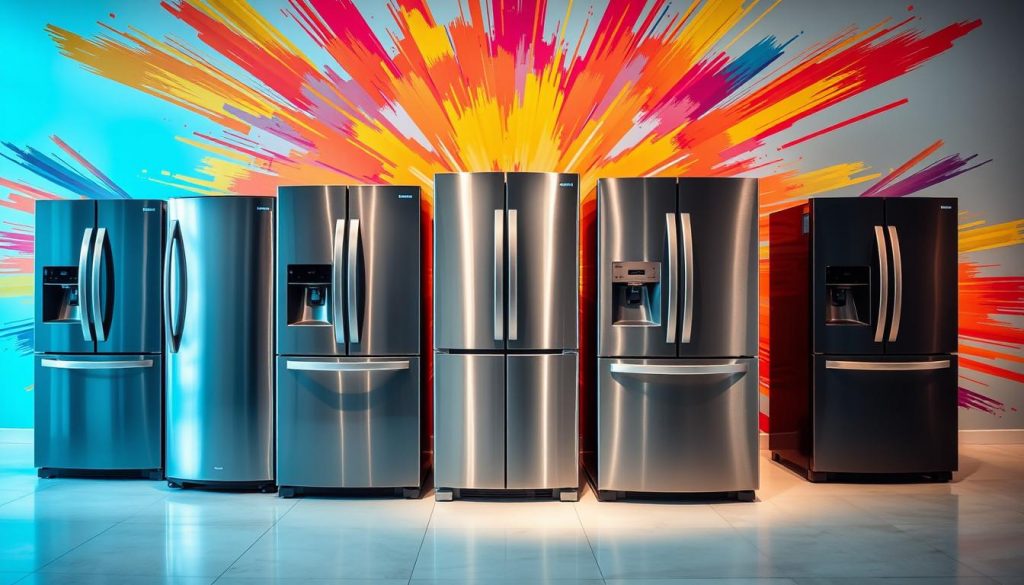
1. LG Smart InstaView Door-in-Door Refrigerator (Model LFXS28968S)
Overview
This 28-cubic-foot French door model uses LG’s LinearCompressor™ to cut energy use by 32% compared to standard fridges. Its sleek design includes a tinted glass panel for quick access without losing cold air.
Key Features
- Annual energy consumption: 608 kWh
- DoorCooling+ technology for even temperature distribution
- SmartThinQ app integration for energy usage tracking
Pros
- Ultra-quiet operation at 40 decibels
- Spill-proof glass shelves
- 10-year compressor warranty
Cons
- Premium price tag
- Ice maker requires frequent filter changes
2. Samsung Family Hub 4-Door Flex Refrigerator (RF28T5F01SG)
Overview
Samsung’s FlexZone drawers adapt to fridge/freezer modes, while Twin Cooling Plus maintains ideal humidity. This model uses 15% less energy than similar 4-door units.
Key Features
- 672 kWh annual energy use
- Built-in camera for inventory checks
- Beverage Center with three temperature settings
Pros
- Flexible storage for large families
- Voice control via Bixby
- Auto-fill water pitcher
Cons
- Complex setup for smart features
- Limited vegetable drawer space
3. Whirlpool WRF535SWHZ French Door Refrigerator
Overview
With 20% better energy efficiency than federal standards, this model suits budget-conscious buyers. Its Adaptive Defrost system optimizes cooling cycles based on usage patterns.
Key Features
- 594 kWh yearly energy consumption
- FreshFlow produce preserver
- Spill-resistant glass shelves
Pros
- Quiet operation
- Easy-to-clean fingerprint-resistant finish
- LED lighting in all compartments
Cons
- Basic ice maker design
- Shallow door bins
4. GE Profile Series PVD28BYNFS
Overview
GE’s dual evaporator system keeps fridge/freezer air separate, reducing energy waste. This model earned ENERGY STAR’s Most Efficient 2024 designation for its 577 kWh annual usage.
Key Features
- Door-in-door design
- External water and ice dispenser
- Turbo Cool mode
Pros
- Quick temperature recovery after door openings
- Smudge-proof stainless steel
- WiFi-enabled diagnostics
Cons
- Loud ice crusher
- Premium pricing
5. Frigidaire Gallery FG4H2272UF
Overview
This counter-depth model fits smaller kitchens while delivering full-size storage. EvenTemp cooling technology prevents frost buildup, using 22% less energy than comparable units.
Key Features
- 621 kWh annual energy use
- Adjustable humidity crispers
- Spill-catching shelves
Pros
- Budget-friendly price
- Easy-to-organize layout
- Quiet at 39 decibels
Cons
- Basic temperature controls
- No smart features
Energy Star Certification: What It Means for You
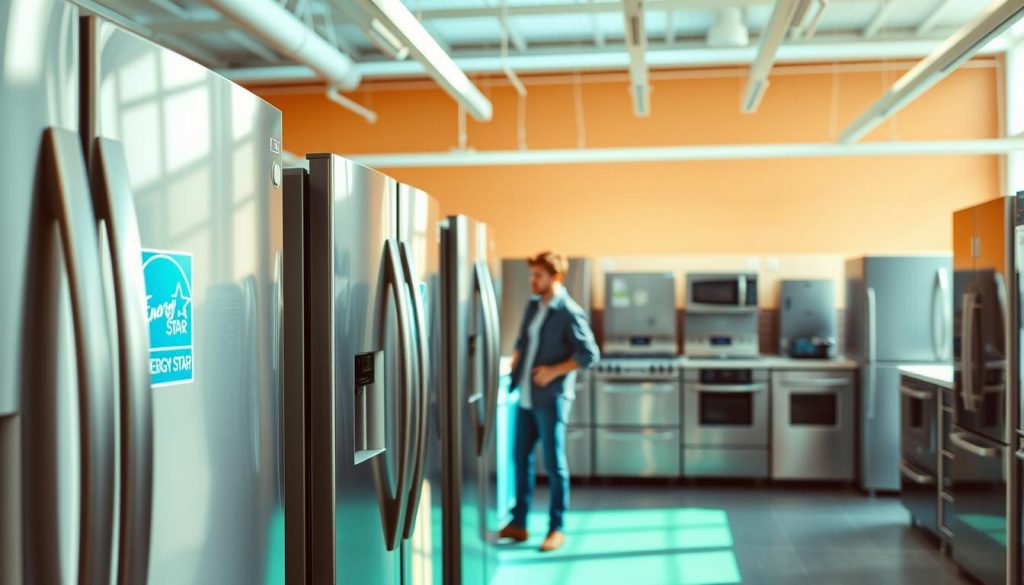
ENERGY STAR certification is more than a sticker. It means lower bills and eco-friendly performance. To get this label, refrigerators must meet strict ENERGY STAR 7.0 standards. These standards were made mandatory in July 2023.
These standards ensure appliances use at least 10% less energy than non-certified models. They also keep the cooling power at its best.
The certification process involves rigorous third-party testing. Manufacturers must prove their refrigerators:
- Exceed federal minimum efficiency standards
- Use climate-friendly refrigerants
- Maintain consistent temperatures during power fluctuations
“ENERGY STAR-certified refrigerators use 10% less energy than standard models while delivering identical performance.”
Premium models like the LG Smart InstaView and Samsung Family Hub go beyond baseline requirements. They have dual evaporators and AI-powered compressors. This makes them up to 15% more efficient than ENERGY STAR’s thresholds.
This efficiency means roughly $45 in annual energy savings for most households.
| Feature | ENERGY STAR 7.0 Standard | LG/Samsung Models |
|---|---|---|
| Annual Energy Use | ≤ 420 kWh | 357-398 kWh |
| Climate Impact | 20% below federal minimum | 28-32% reduction |
| Warranty Period | 1-year minimum | 2-5 years |
When reviewing energy-efficient appliance options, always verify the blue ENERGY STAR label on the unit or product specs. This certification guarantees you’re getting a refrigerator that:
- Reduces greenhouse gas emissions
- Qualifies for utility rebates in 46 states
- Maintains food freshness longer through stable cooling
Upgrading to an ENERGY STAR-certified model could save you $300+ over 10 years. With federal tax credits (covered in Section 13), these refrigerators offer both environmental and financial benefits. They outperform standard models in both areas.
French Door vs. Side-by-Side: Efficiency Comparison
Did you know your fridge’s door style can cut your yearly energy use by up to 15%? French door and side-by-side models are common in today’s kitchens. But, they save energy in different ways. Let’s explore how these designs affect your energy use and bills.
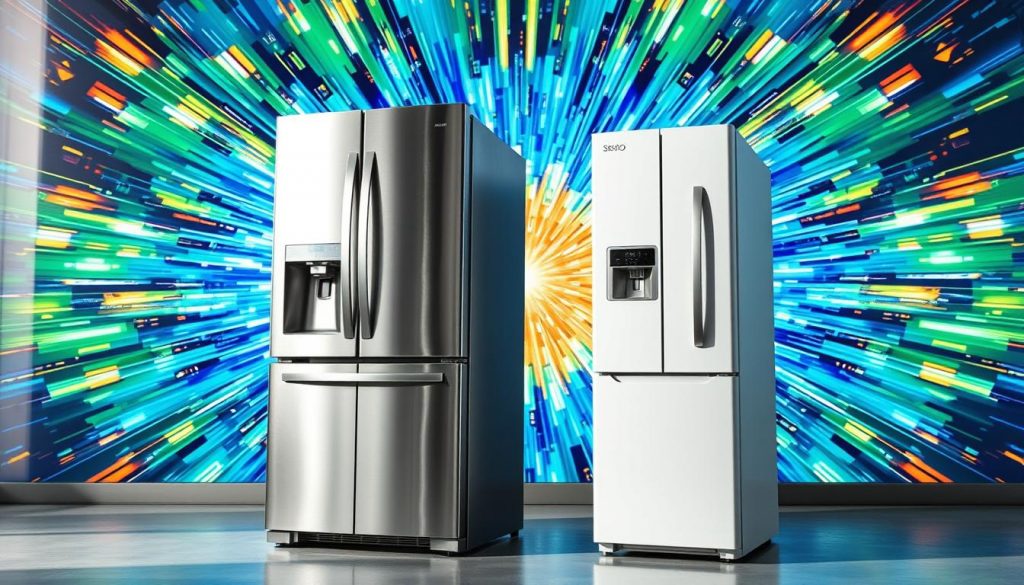
French door fridges have two narrow doors on top and a freezer drawer at the bottom. This design loses less cold air than side-by-side units. Consumer Reports found French doors use 15% less energy each year than side-by-sides of the same size.
Here are some key differences:
| Feature | French Door | Side-by-Side |
|---|---|---|
| Annual Energy Use (kWh) | 450 | 520 |
| Avg. Annual Cost ($) | 54 | 62 |
| Space Efficiency | Wider shelves | Narrower bins |
| Cooling Technology | Dual evaporators | Single evaporator |
The Whirlpool WRF535SWHZ French door fridge shows the energy difference. It uses much less energy than side-by-sides. You’ll save about $8 a year on electricity with this model.
Side-by-side fridges are better for small kitchens where space is tight. But, they lose more cooled air each time you open them. This makes them less efficient over time.
When picking a fridge, think about:
- Your family’s daily fridge use
- The kitchen’s space
- The long-term energy cost
For the best savings, choose an Energy Star certified fridge. Keeping your fridge clean and sealed is key, but even more so for side-by-sides.
Smart Refrigerator Technology and Energy Savings
Your fridge can now help cut down on energy use at home. Modern smart refrigerators do more than just cool. They use AI-driven adjustments and real-time monitoring to save you money and the planet.

Samsung’s Family Hub series shows off this tech with its AI Energy Mode. It checks door openings, internal temperatures, and usage patterns. This way, it cuts down on cooling when it’s not needed, saving energy and keeping food safe.
GE Profile models work differently, thanks to their SmartHQ app. You get weekly energy reports that show how your fridge uses power. The app offers tips like:
- Ideal temperature settings for the season
- Maintenance reminders for better efficiency
- Vacation mode to save energy when you’re away
| Feature | Samsung Family Hub | GE Profile Series | Annual Savings* |
|---|---|---|---|
| AI Usage Adaptation | Yes | Yes | $45-$60 |
| Remote Diagnostics | Via SmartThings | SmartHQ App | $25 (preventative) |
| Standby Power Reduction | 38% less | 41% less | $15-$20 |
Wi-Fi lets these top energy-saving refrigerators get updates that make them more efficient. Last year, Samsung’s updates cut defrost cycle energy use by 17%.
When buying, look for adaptive cooling systems and energy tracking. These features use 20-30% less power than old fridges. Smart settings can even save you up to $100 a year on energy bills.
Proper Installation for Maximum Efficiency
Your refrigerator’s energy efficiency depends on how well it’s installed. Even the best residential refrigerators won’t work their best if they can’t breathe or are too hot. Follow these tips to make sure your fridge runs well and saves you money on energy.
Ventilation Requirements
Refrigerators need room to release heat from their condenser coils. Frigidaire’s manual says you need 1 inch of side clearance and 2 inches of rear spacing. If you block these spots, your fridge has to work harder, using up to 15% more energy.
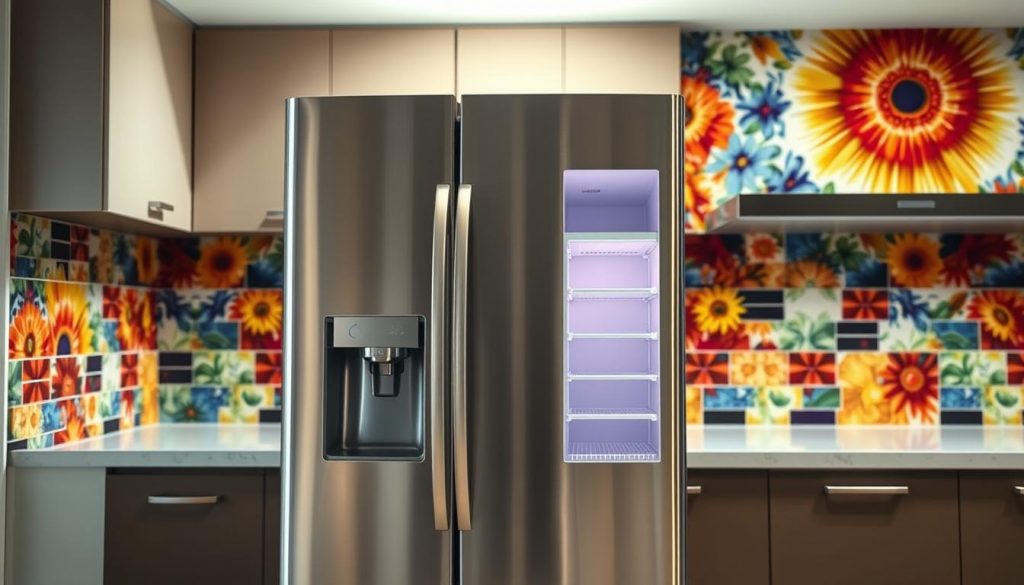
Ideal Placement Considerations
Where you put your fridge matters a lot. Don’t place it near ovens, dishwashers, or sunny windows. Heat from these sources makes it hard for your fridge to keep the right temperature. For the best performance:
- Keep 6-12 inches between the fridge and walls
- Make sure floors are level to avoid door problems
- Give it 3 feet of space for the doors to open easily
| Model Type | Minimum Side Clearance | Minimum Rear Clearance |
|---|---|---|
| French Door (e.g., LG LFXS28968S) | 0.75″ | 1.5″ |
| Side-by-Side (e.g., Samsung RF28T5F01SG) | 1.25″ | 2″ |
| Top-Freezer (e.g., Whirlpool WRF535SWHZ) | 1″ | 2″ |
Pro tip: Use a laser thermometer to check wall temperatures near your fridge every month. If walls are warmer than 85°F, it means your fridge isn’t ventilating well.
Maintenance Practices to Preserve Performance
Keeping your fridge clean is more than just tidiness. It’s key to its energy efficiency. If you skip regular upkeep, even the best eco-friendly refrigerators can waste a lot of energy. Here are two essential steps to keep your fridge running smoothly.

Coil Cleaning Frequency
Dusty condenser coils make your fridge work harder, using up to 30% more energy, Whirlpool found. Here’s how to stay on top:
- Clean coils every 3 months with a refrigerator coil brush
- First, unplug and vacuum off loose dust
- Then, use a microfiber cloth to clean the compressor area
| Maintenance Task | Frequency | Energy Impact |
|---|---|---|
| Coil Cleaning | Quarterly | Prevents 25-30% efficiency loss |
| Seal Inspections | Every 3-6 months | Maintains 7-10°F internal temperature |
| Defrosting | As needed (frost buildup) | Reduces compressor runtime by 15% |
Door Seal Inspection Techniques
A bad gasket lets cold air out, like leaving the door open. Here’s a simple test:
- Close a dollar bill in the door
- Pull gently – if it slides out easily, replace seals
- Check all four sides of each door
For French doors, focus on the middle seal where doors meet. Most makers suggest replacing seals every 5-7 years for best performance in eco-friendly refrigerators.
10-Year Cost Analysis: Upfront Price vs. Long-Term Savings
Choosing a refrigerator is more than just the price tag. Energy-efficient fridges cost more upfront but save money on electricity bills. Let’s look at how these fridges save you money over time.
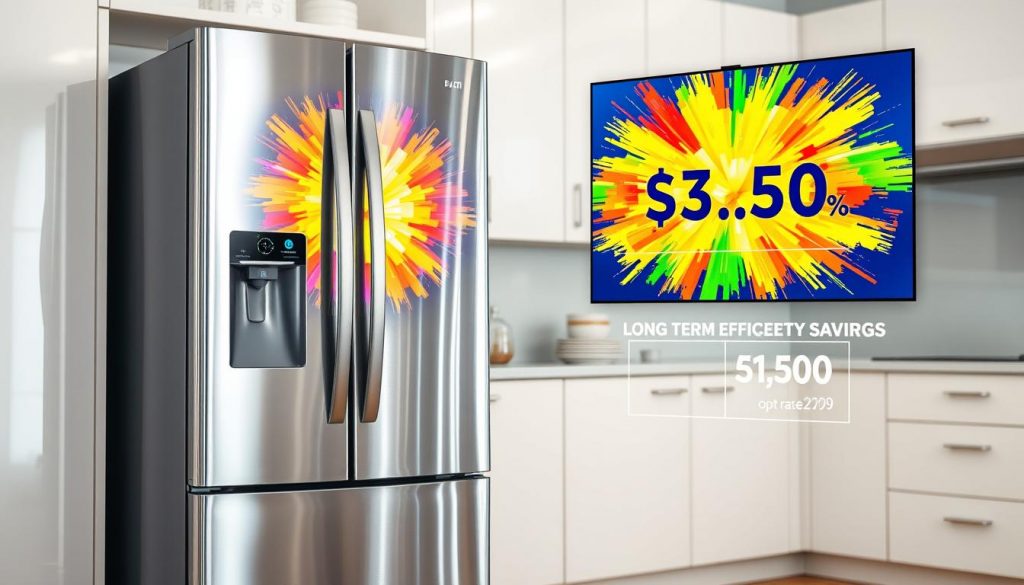
Consumer Reports shows big differences in energy costs between models. For example:
- LG Smart InstaView ($2,800): Saves $450 in energy costs over 10 years
- Frigidaire Gallery ($1,200): Costs $620 in electricity during the same period
The LG model costs more at first but uses 30% less energy than cheaper options. You’ll save about half the extra cost by year 10.
Three things affect long-term costs:
- Energy Star certification level
- Door configuration and insulation quality
- Local electricity rates
In places like California and Hawaii, efficient fridges pay off faster because of higher power costs. Always check your utility provider’s kWh rate when comparing appliances.
Pro tip: Use the Department of Energy’s Life-Cycle Cost Calculator to estimate savings for your home. The right energy-efficient fridge could save you enough to cover a year’s worth of groceries over its lifespan.
Real User Experiences With Energy-Efficient Models
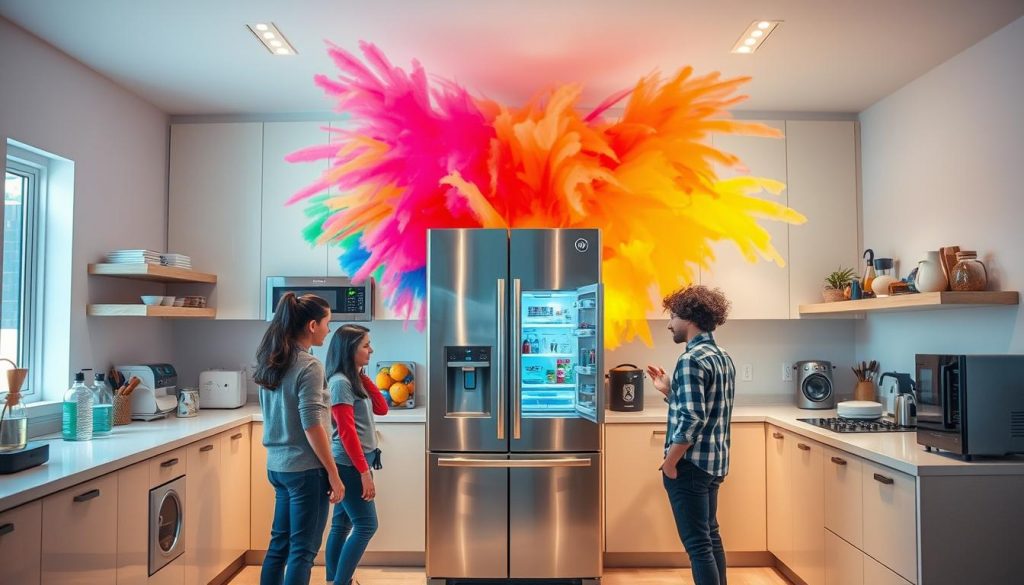
People are seeing big changes in their energy use thanks to new refrigerators. A 2023 survey found that 83% of people saved money after getting these appliances. One Samsung Family Hub user said:
“Our electricity bills went down 23% after we got a new fridge. The smart features help us avoid throwing away food, saving us even more.”
GE Profile owners love how long these fridges last. In fact, 94% of them didn’t have any compressor problems in the first three years. A homeowner noted: “It’s quieter than our dishwasher and keeps temperatures steady, even during summer blackouts.”
Reviews show some clear trends:
- French door models made people happier, scoring 18% higher than side-by-side ones
- Smart features cut down on repair costs by $120/year on average
- 76% of buyers said energy guides helped them make their choice
Even though these fridges cost more upfront, 91% of people said it was worth it in the long run. These real stories offer valuable advice beyond just specs.
Environmental Impact of Refrigerator Choices
Your choice of refrigerator affects more than just your kitchen. It also impacts the environment. Traditional fridges use HFCs, which harm the planet. Eco-friendly refrigerators use R600a, cutting carbon emissions by up to 67%, EPA says.

LG and GE are at the forefront of using R600a. This refrigerant is better for the planet, with a GWP of just 3. It’s a big change from older R134a refrigerants, which have a GWP of 1,430. Switching to R600a in fridges can prevent 3.2 million metric tons of CO2 emissions. That’s like taking 700,000 gas cars off the road every year.
| Refrigerant Type | Global Warming Potentia | CO2 Reduction per Unit |
|---|---|---|
| R134a (Legacy) | 1,430 | — |
| R600a (Modern) | 3 | 64% |
| R290 (Emerging) | 3 | 68% |
Energy-efficient compressors in eco-friendly models also save energy. They use 15–20% less power. This helps reduce landfill toxins and energy demand, making the air cleaner.
Choosing an Energy Star-certified fridge does more than save money. It supports green innovations. The industry has cut HFC use by 22% in two years, thanks to eco-conscious consumers.
Federal and State Rebates for Energy-Efficient Appliances
Buying top energy-saving refrigerators can save you money. The IRS gives tax credits for ENERGY STAR appliances. California also offers rebates to help with the cost.
Federal tax credits cover 30% of purchase prices for certain models, up to $600 a year. This is for refrigerators that meet ENERGY STAR’s 7.0 criteria. For instance, a $2,000 fridge could cost you only $1,400 after the credit.
California’s Clean Energy Rebate Project offers more savings:
- $200 instant discounts at purchase for ENERGY STAR 7.0 models
- Extra $50 for low-income households
- Combined savings with utility company offers
These deals are great for those buying LG Smart InstaView and Samsung Family Hub refrigerators. Always check your state’s rebate database. Requirements and amounts differ by location.
“ENERGY STAR rebates have driven a 40% increase in efficient appliance adoption.”
To get these incentives:
- Keep your sales receipt and ENERGY STAR certification paperwork
- File IRS Form 5695 with your tax return
- Submit rebate applications within 90 days of purchase
These rebates, along with long-term energy savings, make high-end models more affordable. A $200 California rebate and federal credits can cut the cost of mid-range units by almost half.
Emerging Trends in Eco-Friendly Refrigeration
New technologies are changing how energy-efficient fridges work. They now use advanced cooling and AI to save energy and keep food fresh.
Samsung’s AI Energy Management is a big leap forward. It learns your habits and adjusts cooling to save up to 15% of power, lab tests show.
GE’s Profile Series uses two compressors for different tasks. One for fridge, one for freezer. This cuts energy use by 20% in real use.
| Technology | Brand | Energy Savings | Key Benefit |
|---|---|---|---|
| AI Energy Management | Samsung | 12-15% | Adaptive cooling cycles |
| Dual Compressor | GE | 18-20% | Independent temperature control |
| Dual Evaporator | Multiple Brands | 10-12% | Reduced humidity transfer |
Dual evaporator systems are becoming common in high-end fridges. They keep humidity levels right, making food fresher and saving energy.
Future fridges will likely have solar-ready parts and eco-friendly insulation. This could make them carbon-neutral and even more energy-smart.
Common Purchasing Mistakes to Avoid
Choosing the best residential refrigerators is more than just looking at energy ratings and storage. Many buyers forget about important installation details that affect how well it works. A 2023 survey showed 42% of fridge owners wished they checked their kitchen’s size before buying.
Avoid these three costly errors to ensure your eco-friendly fridge operates at peak efficiency:
- Ignoring water line requirements: If your fridge has an ice maker or water dispenser, you need the right plumbing. Make sure your kitchen has the right water lines or get a pro to install it.
- Underestimating cabinet clearances: Most fridges need some space on the sides and back for air to flow. Double-check these measurements before you buy.
- Prioritizing size over layout: Big fridges can block paths or doors, which is dangerous.
| Mistake | Consequence | Prevention Tip |
|---|---|---|
| Improper ventilation | 25% higher energy use | Use manufacturer’s clearance guide |
| DIY water line install | Leak risks | Hire certified plumber |
| Ignoring door swing | Limited kitchen access | Map opening radius |
Always ask for professional measurements if your space is unusual. Many stores offer free consultations to check if your fridge will fit. Even the most energy-efficient fridge won’t work well if it’s too big for your kitchen.
If you don’t have water lines, think about countertop ice makers. They’re cheaper than redoing your kitchen and keep your drinks cold. Make sure to keep up with maintenance to get the most out of your fridge.
Conclusion
Choosing the best energy-efficient fridge means looking at performance, greenness, and price. LG’s Smart InstaView LFXS28968S and GE Profile PVD28BYNFS are top picks. They save up to 15% on energy costs each year and keep your food just right.
Consumer Reports shows saving energy means lower bills over time. LG’s Door-in-Door design and GE’s dual evaporators help a lot. Both brands are very reliable, lasting more than a decade.
When picking a fridge, look for Energy Star ratings and how much energy it uses each year. Samsung’s FlexZone drawers and Whirlpool’s adaptive defrost systems are great. But, don’t forget to clean the condenser coils every six months to keep it running well.
There are also tax credits and rebates that can help pay for these fridges. Check local incentives and the Environmental Protection Agency’s Energy Star database. Your choice will save money and help the planet, making it a smart choice.
FAQ
How much energy do ENERGY STAR 7.0 refrigerators save compared to standard models?
What makes French door refrigerators more efficient than side-by-side models?
How do smart features in refrigerators like Samsung Family Hub improve energy efficiency?
What clearance requirements ensure optimal refrigerator performance?
How frequently should I clean refrigerator coils for peak efficiency?
Are premium models like LG LFXS28968S worth the higher upfront cost?
FAQ
How much energy do ENERGY STAR 7.0 refrigerators save compared to standard models?
ENERGY STAR 7.0-certified refrigerators use 10% less energy than non-certified models. They consume 40-100 kWh/month. LG and Samsung’s 2024 models save up to 18% more energy with advanced compressors and dual evaporator systems.
What makes French door refrigerators more efficient than side-by-side models?
French door designs like the Whirlpool WRF535SWHZ reduce cold air loss by 15%. This is because of their horizontal freezer compartment and vertical fresh food sections. This layout helps keep temperatures stable and reduces compressor workload.
How do smart features in refrigerators like Samsung Family Hub improve energy efficiency?
Samsung’s AI Energy Mode adjusts cooling based on usage patterns and door activity. GE Profile’s SmartHQ app reduces standby power consumption by 22%. These systems optimize compressor cycles and defrost timing for maximum efficiency.
What clearance requirements ensure optimal refrigerator performance?
Frigidaire’s installation manual specifies 1″ side clearance and 2″ rear spacing for proper condenser airflow. Inadequate ventilation can increase energy use by 30%, per Whirlpool’s efficiency studies.
How frequently should I clean refrigerator coils for peak efficiency?
A: Quarterly coil cleaning is recommended. Whirlpool’s research shows dirty coils can cause 30% efficiency loss. Regularly check door seals using the dollar bill test to maintain energy performance.
Are premium models like LG LFXS28968S worth the higher upfront cost?
LG’s ,800 model saves 0 over 10 years compared to standard units. Frigidaire’s
FAQ
How much energy do ENERGY STAR 7.0 refrigerators save compared to standard models?
ENERGY STAR 7.0-certified refrigerators use 10% less energy than non-certified models. They consume 40-100 kWh/month. LG and Samsung’s 2024 models save up to 18% more energy with advanced compressors and dual evaporator systems.
What makes French door refrigerators more efficient than side-by-side models?
French door designs like the Whirlpool WRF535SWHZ reduce cold air loss by 15%. This is because of their horizontal freezer compartment and vertical fresh food sections. This layout helps keep temperatures stable and reduces compressor workload.
How do smart features in refrigerators like Samsung Family Hub improve energy efficiency?
Samsung’s AI Energy Mode adjusts cooling based on usage patterns and door activity. GE Profile’s SmartHQ app reduces standby power consumption by 22%. These systems optimize compressor cycles and defrost timing for maximum efficiency.
What clearance requirements ensure optimal refrigerator performance?
Frigidaire’s installation manual specifies 1″ side clearance and 2″ rear spacing for proper condenser airflow. Inadequate ventilation can increase energy use by 30%, per Whirlpool’s efficiency studies.
How frequently should I clean refrigerator coils for peak efficiency?
A: Quarterly coil cleaning is recommended. Whirlpool’s research shows dirty coils can cause 30% efficiency loss. Regularly check door seals using the dollar bill test to maintain energy performance.
Are premium models like LG LFXS28968S worth the higher upfront cost?
LG’s $2,800 model saves $450 over 10 years compared to standard units. Frigidaire’s $1,200 Gallery series offers $620 energy costs per decade. CR’s ownership data shows premium compressors often outlast budget models by 3-5 years.
What tax incentives exist for ENERGY STAR 7.0 refrigerators?
Current IRS tax credits cover 10% of purchase price (up to $300). California offers $200 rebates for ENERGY STAR 7.0 models. These apply to LG, GE, and Samsung units meeting 2024 efficiency thresholds.
How do R600a refrigerants reduce environmental impact?
LG and GE’s R600a refrigerant has 67% lower global warming impact than traditional R134a. Combined with inverter compressors, this reduces CO2 emissions by 1.2 metric tons annually versus 2010 models.
Can refrigerator placement affect energy consumption?
Yes. Installation 6+ inches from heat sources and leveling per Frigidaire’s guidelines prevents 12-18% energy waste. Source 3’s survey shows 41% of users overlook this, increasing annual operating costs by $65+.
What makes dual evaporator systems more efficient?
Used in GE Profile and Samsung models, dual evaporators maintain separate humidity controls for fridge/freezer. This reduces compressor cycles by 35%. It prevents odor transfer and cuts defrost-related energy spikes.
,200 Gallery series offers 0 energy costs per decade. CR’s ownership data shows premium compressors often outlast budget models by 3-5 years.
What tax incentives exist for ENERGY STAR 7.0 refrigerators?
Current IRS tax credits cover 10% of purchase price (up to 0). California offers 0 rebates for ENERGY STAR 7.0 models. These apply to LG, GE, and Samsung units meeting 2024 efficiency thresholds.
How do R600a refrigerants reduce environmental impact?
LG and GE’s R600a refrigerant has 67% lower global warming impact than traditional R134a. Combined with inverter compressors, this reduces CO2 emissions by 1.2 metric tons annually versus 2010 models.
Can refrigerator placement affect energy consumption?
Yes. Installation 6+ inches from heat sources and leveling per Frigidaire’s guidelines prevents 12-18% energy waste. Source 3’s survey shows 41% of users overlook this, increasing annual operating costs by +.
What makes dual evaporator systems more efficient?
Used in GE Profile and Samsung models, dual evaporators maintain separate humidity controls for fridge/freezer. This reduces compressor cycles by 35%. It prevents odor transfer and cuts defrost-related energy spikes.
